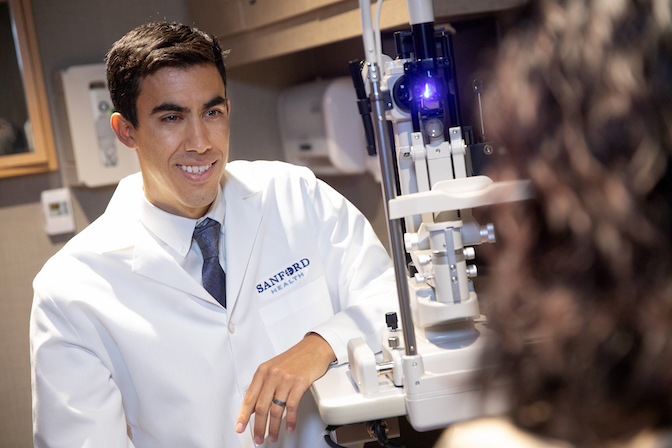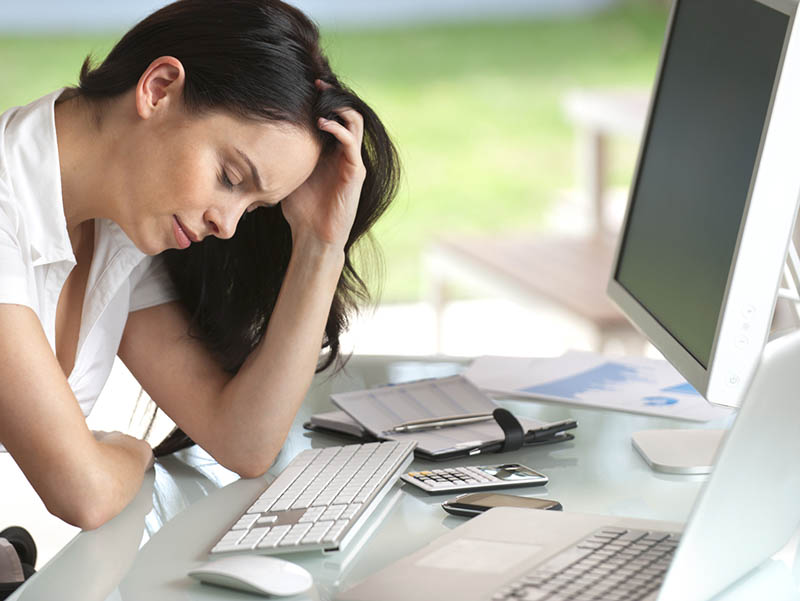As we continue to practice social distancing in an effort to slow the spread of the coronavirus, our computer screens have become our windows to the world.
Via work, school, socializing and even doctor visits, a lot of things are coming at us through tablet, desktop and laptop screens.
As a result, we’re asking a lot of our eyes. Eye strain is not an uncommon occasional discomfort for most of us during the best of times, but the demands for many have increased as they replace that six feet of social distancing with time in front of a computer.
To start with, why can too much time in front of a screen be tough on the eyeballs?
“The problem with the screen time is not just the lights itself on the screen and the glare,” said Dr. Andrew Ollerton, who practices ophthalmology and ophthalmic surgery and specializes in cornea care for Sanford Health.
“In addition, we don’t blink as often as we think we do when we’re in front of screens. Normally we’re blinking 15 to 20 times a minute. That goes down to five times a minute when we’re looking at a computer. Less blinking leads to the eye drying out, and you can feel this as a gritty, scratchy or sharp poking sensation on the eye, or your eyes can feel tired and heavy and strained.”
Not enough blinking
Those missed blinking opportunities have a way of adding up.

Photo by Sanford Health
“Every blink cleanses and moisturizes the eye. This is critical to maintain a clear optical system and see well,” Dr. Ollerton said. “Every blink expresses oils from specialized glands in the eyelids. These oils lay over top of the watery tear film coating the surface of the eye and prevent this water from evaporating in between blinks.”
It makes sense that your eyes dry out because of that. It also makes sense that if you blink a few more times, it’s going to help.
“Take a break and blink several times,” Dr. Ollerton said. “That’s about the easiest thing you can do.”
Ollerton went on to list several other ways we can minimize the discomfort associated with screen time.
Ways of alleviating eye strain
Over-the-counter lubricating eye drops: Up to four times a day is fine. More than that, and you should pick out a brand that does not contain preservatives.
The 20/20/20 rule: Take regular breaks from looking at the screen. Every 20 minutes, sit back and look at something that is 20 feet away for at least 20 seconds.
Wear proper eyeglasses: Sometimes without being aware of it, an improper prescription – or the lack of any glasses at all – can cause additional eye strain. Standard distance from a computer screen is about 25 inches. Focusing on something at that distance for an extended time can make for an unnecessary eyeball workout if your eyes are compensating for uncorrected or under-corrected vision.
“You can get prescription glasses that help you focus at that distance and relax the muscles in your eyes,” Dr. Ollerton said. “Sometimes you don’t realize how much your eyes are straining.”
Adjust the brightness and contrast on your screen: If your screen is a lot brighter than the room you’re in, that can be a factor. Go to the settings and cut the brightness down. In addition, a higher contrast can take some of the work out of focusing.
Cut down the glare: If you’re working in an area where glare is a problem, there are matte screens and filters available that can make it more comfortable to look at the screen for extended lengths of time.
Adjust your distance from the screen: Sit an arm’s length away from the computer. Being too close can make it worse. Best is about 25 inches with your eyes looking slightly downward.
Take a break from contacts: If you’re a contact wearer and they’re occasionally irritating, take them out for a while and wear glasses. Contacts can accelerate eye dryness.
To review: Taking breaks from the screen, blinking and making sure your eyes are lubricated are very important in alleviating eye strain. Avoid glare, change the contrast and brightness on your screen and don’t sit too close to the screen. Also, make sure your glasses prescription is up-to-date. If you still are having problems, it’s important to get a full eye exam. There are prescription medications and other interventions that can help with dryness as well as other factors that could be contributing to your eye strain.
More stories
- Pandemic learning can strain children’s eyes
- Retina specialist helps when health & eye concerns overlap
- How to avoid stress eating while you stay home
…
